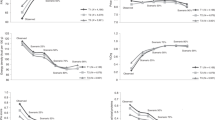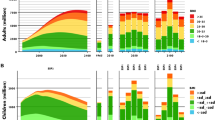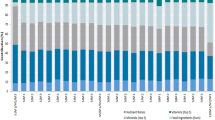Abstract
To identify environmentally sustainable foods that promote health, we combined nutritional health-based and 18 environmental indicators to evaluate, classify and prioritize individual foods. Specifically for nutrition, we developed the Health Nutritional Index to quantify marginal health effects in minutes of healthy life gained or lost of 5,853 foods in the US diet, ranging from 74 min lost to 80 min gained per serving. Environmental impacts showed large variations and were found to be correlated with global warming, except those related to water use. Our analysis also indicated that substituting only 10% of daily caloric intake from beef and processed meat for fruits, vegetables, nuts, legumes and selected seafood could offer substantial health improvements of 48 min gained per person per day and a 33% reduction in dietary carbon footprint.
This is a preview of subscription content, access via your institution
Access options
Access Nature and 54 other Nature Portfolio journals
Get Nature+, our best-value online-access subscription
$29.99 / 30 days
cancel any time
Subscribe to this journal
Receive 12 digital issues and online access to articles
$119.00 per year
only $9.92 per issue
Buy this article
- Purchase on Springer Link
- Instant access to full article PDF
Prices may be subject to local taxes which are calculated during checkout






Similar content being viewed by others
Data availability
Data are available from the corresponding author upon reasonable request.
Code availability
Code is available from the corresponding author upon reasonable request.
References
Tilman, D. & Clark, M. Global diets link environmental sustainability and human health. Nature 515, 518–522 (2014).
Afshin, A. et al. Health effects of dietary risks in 195 countries, 1990–2017: a systematic analysis for the Global Burden of Disease Study 2017. Lancet 393, 1958–1972 (2019).
Gakidou, E. et al. Global, regional, and national comparative risk assessment of 84 behavioural, environmental and occupational, and metabolic risks or clusters of risks, 1990–2016: a systematic analysis for the Global Burden of Disease Study 2016. Lancet 390, 1345–1422 (2017).
Foley, J. A. et al. Solutions for a cultivated planet. Nature 478, 337–342 (2011).
Herrero, M. et al. Greenhouse gas mitigation potentials in the livestock sector. Nat. Clim. Change 6, 452–461 (2016).
Poore, J. & Nemecek, T. Reducing food’s environmental impacts through producers and consumers. Science 360, 987–992 (2018).
Paulot, F. & Jacob, D. J. Hidden cost of US agricultural exports: particulate matter from ammonia emissions. ammonia pollution from farming may exact hefty health costs. Environ. Sci. Technol. 48, 903–908 (2014).
Springmann, M. et al. Options for keeping the food system within environmental limits. Nature 562, 519–525 (2018).
Gerten, D. et al. Feeding ten billion people is possible within four terrestrial planetary boundaries. Nat. Sustain. 3, 200–208 (2020).
Heck, V., Hoff, H., Wirsenius, S., Meyer, C. & Kreft, H. Land use options for staying within the planetary boundaries–synergies and trade-offs between global and local sustainability goals. Glob. Environ. Change 49, 73–84 (2018).
Campbell, B. M. et al. Agriculture production as a major driver of the Earth system exceeding planetary boundaries. 22, 8 (2017).
Bowles, N., Alexander, S. & Hadjikakou, M. The livestock sector and planetary boundaries: a ‘limits to growth’ perspective with dietary implications. Ecol. Econ. 160, 128–136 (2019).
Godfray, H. C. J. et al. Food security: the challenge of feeding 9 billion people. Science 327, 812–818 (2010).
Willett, W. et al. Food in the Anthropocene: the EAT–Lancet Commission on healthy diets from sustainable food systems. Lancet 393, 447–492 (2019).
2017 Food & Health Survey (IFIC Foundation, 2017).
Climate Change and Land (IPCC, 2019).
van’t Riet, J., Sijtsema, S. J., Dagevos, H. & de Bruijn, G. J. The importance of habits in eating behaviour. An overview and recommendations for future research. Appetite 57, 585–596 (2011).
Nestle, M. et al. Behavioral and social influences on food choice. Nutr. Rev. 56, 50–64 (1998).
Bachman, J., Christaldi, J. & Tomasko, A. Translating MyPlate into food selections that meet dietary guidelines recommendations. J. Hum. Sci. Ext. 4, 111–123 (2016).
Wall, C. L., Gearry, R. B., Pearson, J., Parnell, W. & Skidmore, P. M. L. Dietary intake in midlife and associations with standard of living, education and nutrition literacy. J. New Zeal. Med. Assoc. 127, 30–40 (2014).
Kennedy, E. & Davis, C. A. Dietary guidelines 2000—the opportunity and challenges for reaching the consumer. J. Am. Diet. Assoc. 100, 1462–1465 (2000).
Arsenault, J. E., Fulgoni, V. L., Hersey, J. C. & Muth, M. K. A novel approach to selecting and weighting nutrients for nutrient profiling of foods and diets. J. Acad. Nutr. Diet. 112, 1968–1975 (2012).
Sukhdev, P. Smarter metrics will help fix our food system world-view. Nature 558, 7 (2018).
Clune, S., Crossin, E. & Verghese, K. Systematic review of greenhouse gas emissions for different fresh food categories. J. Clean. Prod. 140, 766–783 (2017).
Stylianou, K. S. et al. A life cycle assessment framework combining nutritional and environmental health impacts of diet: a case study on milk. Int. J. Life Cycle Assess. 21, 734–746 (2016).
Heller, M. C., Keoleian, G. A. & Willett, W. C. Toward a life cycle-based, diet-level framework for food environmental impact and nutritional quality assessment: a critical review. Environ. Sci. Technol. 47, 12632–12647 (2013).
Fulgoni, V. L., Keast, D. R. & Drewnowski, A. Development and validation of the nutrient-rich foods index: a tool to measure nutritional quality of foods. J. Nutr. 139, 1549–1554 (2009).
Katz, D. L. et al. The stratification of foods on the basis of overall nutritional quality: the Overall Nutritional Quality Index. Am. J. Heal. Promot. 24, 133–143 (2009).
Arvaniti, F. & Panagiotakos, D. B. Healthy indexes in public health practice and research: a review. Crit. Rev. Food Sci. Nutr. 48, 317–327 (2008).
Clark, M. A., Springmann, M., Hill, J. & Tilman, D. Multiple health and environmental impacts of foods. Proc. Natl Acad. Sci. USA 116, 23357–23362 (2019).
Kesse-Guyot, E. et al. Sustainability analysis of French dietary guidelines using multiple criteria. Nat. Sustain. 3, 377–385 (2020).
Springmann, M., Godfray, H. C. J., Rayner, M. & Scarborough, P. Analysis and valuation of the health and climate change cobenefits of dietary change. Proc. Natl Acad. Sci. USA 113, 4146–4151 (2016).
Scientific Report of the 2015 Dietary Guidelines Advisory Committee (Dietary Guidelines Advisory Committee, 2015).
Saarinen, M. et al. Life cycle assessment approach to the impact of home-made, ready-to-eat and school lunches on climate and eutrophication. J. Clean. Prod. 28, 177–186 (2012).
Weidema, B. P. & Stylianou, K. S. Nutrition in the life cycle assessment of foods—function or impact? Int. J. Life Cycle Assess. 25, 1210–1216 (2020).
Fulgoni, V. L. III, Wallace, T. C., Stylianou, K. S. & Jolliet, O. Calculating intake of dietary risk components used in the global burden of disease studies from the whatwe eat in america/national health and nutrition examination surveys. Nutrients 10, 1441 (2018).
Kunkel, D. & McKinley, C. Developing ratings for food products: Lessons learned from media rating systems. J. Nutr. Educ. Behav. 46, 578–588 (2007).
Bulle, C. et al. IMPACT World+: a globally regionalized life cycle impact assessment method. Int. J. Life Cycle Assess. 24, 1653–1674 (2019).
Meier, T. & Christen, O. Environmental impacts of dietary recommendations and dietary styles: Germany as an example. Environ. Sci. Technol. 47, 877–888 (2013).
Greenhouse Gas Equivalencies Calculator (Environmental Protection Agency, 2019); https://www.epa.gov/energy/greenhouse-gas-equivalencies-calculator
Masset, G., Vieux, F. & Darmon, N. Which functional unit to identify sustainable foods? Public Health Nutr. 18, 2488–2497 (2015).
Saarinen, M., Fogelholm, M., Tahvonen, R. & Kurppa, S. Taking nutrition into account within the life cycle assessment of food products. J. Clean. Prod. 149, 828–844 (2017).
De Schryver, A. M., Brakkee, K. W., Goedkoop, M. J. & Huijbregts, M. A. J. Characterization factors for global warming in life cycle assessment based on damages to humans and ecosystems. Environ. Sci. Technol. 43, 1689–1695 (2009).
Liebe, D. L., Hall, M. B. & White, R. R. Contributions of dairy products to environmental impacts and nutritional supplies from United States agriculture. J. Dairy Sci. 103, 10867–10881 (2020).
Avadí, A., Vázquez-Rowe, I., Symeonidis, A. & Moreno-Ruiz, E. First series of seafood datasets in Ecoinvent: setting the pace for future development. Int. J. Life Cycle Assess. 25, 1333–1342 (2020).
Avadí, A., Henriksson, P. J. G., Vázquez-Rowe, I. & Ziegler, F. Towards improved practices in life cycle assessment of seafood and other aquatic products. Int. J. Life Cycle Assess. 23, 979–981 (2018).
Clark, M. & Tilman, D. Comparative analysis of environmental impacts of agricultural production systems, agricultural input efficiency, and food choice. Environ. Res. 12, 064016 (2017).
Reinhardt, S. L. et al. Systematic review of dietary patterns and sustainability in the United States. Adv. Nutr. 11, 1016–1031 (2020).
Guide to Creating a Front of Pack (FoP) Nutrition Label for Pre-packed Products Sold through Retail Outlets (UK Department of Health, 2013); https://doi.org/10.1093/heapro/dap032
van Dooren, C., Douma, A., Aiking, H. & Vellinga, P. Proposing a novel index reflecting both climate impact and nutritional impact of food products. Ecol. Econ. 131, 389–398 (2017).
Drescher, L. S., Thiele, S. & Mensink, G. B. M. A new index to measure healthy food diversity better reflects a healthy diet than traditional measures. J. Nutr. 137, 647–651 (2007).
Dwivedi, S. L. et al. Diversifying food systems in the pursuit of sustainable food production and healthy diets. Trends Plant Sci. 22, 842–856 (2017).
White, R. R. & Hall, M. B. Nutritional and greenhouse gas impacts of removing animals from US agriculture. Proc. Natl Acad. Sci. USA 114, E10301–E10308 (2017).
Mozaffarian, D. Foods, nutrients, and health: when will our policies catch up with nutrition science? Lancet Diabetes Endocrinol. 5, 85–88 (2017).
Chukalla, A. D., Krol, M. S. & Hoekstra, A. Y. Green and blue water footprint reduction in irrigated agriculture: effect of irrigation techniques, irrigation strategies and mulching. Hydrol. Earth Syst. Sci. 19, 4877–4891 (2015).
Huang, G. et al. Water-saving agriculture can deliver deep water cuts for China. Resour. Conserv. Recycl. 154, 104578 (2020).
Henderson, A. D. et al. Spatial variability and uncertainty of water use impacts from US feed and milk production. Environ. Sci. Technol. 51, 2382–2391 (2017).
Bidlack, W. R., Wang, W. & Clemens, R. Water: the world’s most precious resource. J. Food Sci. 69, crh55–crh60 (2004).
Pfister, S. & Bayer, P. Monthly water stress: spatially and temporally explicit consumptive water footprint of global crop production. J. Clean. Prod. 73, 52–62 (2014).
Boulay, A. M., Lenoir, L. & Manzardo, A. Bridging the data gap in the water scarcity footprint by using crop-specific AWARE factors. Water 11, 2634 (2019).
Mekonnen, M. M. & Hoekstra, A. Y. A global assessment of the water footprint of farm animal products. Ecosystems 15, 401–415 (2012).
Mekonnen, M. M. & Hoekstra, A. Y. The Green, Blue and Grey Water Footprint of Farm Animals and Animal Products. Value of Water Research Report Series No. 48 (UNESCO, 2010).
Heller, M. C., Willits-Smith, A., Meyer, R., Keoleian, G. A. & Rose, D. Greenhouse gas emissions and energy use associated with production of individual self-selected US diets. Environ. Res. Lett. 13, 044004 (2018).
Hospido, A., Davis, J., Berlin, J. & Sonesson, U. A review of methodological issues affecting LCA of novel food products. Int. J. Life Cycle Assess. 15, 44–52 (2010).
National Academies of Sciences Engineering and Medicine. Dietary Reference Intakes for Sodium and Potassium (National Academies Press, 2019); https://doi.org/10.17226/25353
Fiolet, T. et al. Consumption of ultra-processed foods and cancer risk: results from NutriNet-Santé prospective cohort. Br. Med. J. 360, 322 (2018).
Rico-Campà, A. et al. Association between consumption of ultra-processed foods and all cause mortality: SUN prospective cohort study. Br. Med. J. 365, 1949 (2019).
Liu, G. et al. Meat cooking methods and risk of type 2 diabetes: results from three prospective cohort studies. Diabetes Care 41, 1049–1060 (2018).
Parker, L., Burns, A. C. & Sanchez, E. Local Government Actions to Prevent Childhood Obesity (National Academies Press, 2010); https://doi.org/10.17226/12674
Härkänen, T. et al. The welfare effects of health-based food tax policy. Food Policy 49, 196–206 (2014).
Springmann, M. et al. Mitigation potential and global health impacts from emissions pricing of food commodities. Nat. Clim. Chang. 7, 69–74 (2017).
Mozaffarian, D. et al. Cost-effectiveness of financial incentives and disincentives for improving food purchases and health through the US Supplemental Nutrition Assistance Program (SNAP): a microsimulation study. PLoS Med. 15, e1002661 (2018).
National Health and Nutrition Examination Survey (NHANES) (National Center for Health Statistics, 2018); https://www.cdc.gov/nchs/nhanes/index.htm
US Department of Agriculture Food Coding Scheme (Centers for Disease Control); https://www.cdc.gov/nchs/tutorials/Dietary/SurveyOrientation/ResourceDietaryAnalysis/Info2.htm
Food Labeling, Nutrition, Reporting and Recordkeeping Requirements (FR Citation:81 FR 34000) Federal Register Vol. 81 (Food and Drug Administration, 2016); https://www.regulations.gov/document?D=FDA-2004-N-0258-0136
Roy, P. et al. A review of life cycle assessment (LCA) on some food products. J. Food Eng. 90, 1–10 (2009).
GBD Results Tool (Institute for Health Metrics and Evaluation, 2018); http://ghdx.healthdata.org/gbd-results-tool
Global Burden of Disease Study 2016 (GBD 2016) Population Estimates 1950–2016 (Global Burden of Disease Collaborative Network, 2017); http://ghdx.healthdata.org/record/global-burden-disease-study-2016-gbd-2016-population-estimates-1950-2016
Diet, Nutrition, and the Prevention of Chronic Diseases: Report of a Joint WHO/FAO Expert Consultation (World Health Organization, 2003).
Ridoutt, B. & Huang, J. Three main ingredients for sustainable diet research. Environ. Sci. Technol. 53, 2948–2949 (2019).
Stylianou, K. S. Nutritional and Environmental Impacts of Foods on Human Health Ch. 4, PhD thesis, Univ. Michigan (2018).
Mekonnen, M. M. & Hoekstra, A. Y. The green, blue and grey water footprint of crops and derived crop products. Hydrol. Earth Syst. Sci. 15, 1577–1600 (2011).
Hong, J., Shaked, S., Rosenbaum, R. K. & Jolliet, O. Analytical uncertainty propagation in life cycle inventory and impact assessment: application to an automobile front panel. Int. J. Life Cycle Assess. 15, 499–510 (2010).
Acknowledgements
The authors thank P. Fantke and K. Herold for comments on the manuscript and Quantis for providing access to the World Food LCA Database. This research was funded by an unrestricted grant from the National Dairy Council and the University of Michigan Dow Sustainability Fellowship.
Author information
Authors and Affiliations
Contributions
K.S.S., O.J. and V.L.F. conceptualized the study, devised the methodology, curated the data, and reviewed and edited the paper. K.S.S. performed the formal analysis and wrote the original draft.
Corresponding authors
Ethics declarations
Competing interests
K.S.S. declares no conflicts of interest. V.L.F. conducts data analyses of the National Health and Nutrition Examination Survey for numerous members of the food industry. O.J. has received funding on unrelated projects from the US Environmental Protection Agency, the US Department of Agriculture, the American Chemistry Council Long-Range Research Initiative and Unilever, and became part, after submission of the present manuscript, of the Sustainable Nutrition Scientific Board created with unrestricted support from Nutella. The funding organizations did not have a role in the manuscript development.
Additional information
Peer review information Nature Food thanks Sarah Reinhardt and the other, anonymous, reviewer(s) for their contribution to the peer review of this work.
Publisher’s note Springer Nature remains neutral with regard to jurisdictional claims in published maps and institutional affiliations.
Supplementary information
Supplementary Information
Supplementary text (sections 1–5), Figs. 1–22 and Tables 1–15.
Supplementary Data 1
This file contains the underlying nutritional and environmental data used to estimate the corresponding impacts of the 167 commonly used food in the average US diet. Impacts are reported per serving. The substitution order used in the replacement analysis is also reported.
Supplementary Data 2
This file contains Supplementary Tables 1–15.
Rights and permissions
About this article
Cite this article
Stylianou, K.S., Fulgoni, V.L. & Jolliet, O. Small targeted dietary changes can yield substantial gains for human health and the environment. Nat Food 2, 616–627 (2021). https://doi.org/10.1038/s43016-021-00343-4
Received:
Accepted:
Published:
Issue Date:
DOI: https://doi.org/10.1038/s43016-021-00343-4
This article is cited by
-
Unacceptable use of substandard metrics in policy decisions which mandate large reductions in animal-source foods
npj Science of Food (2024)
-
Biofortification versus diversification to fight micronutrient deficiencies: an interdisciplinary review
Food Security (2024)
-
Review of Diet Quality Indices that can be Applied to the Environmental Assessment of Foods and Diets
Current Nutrition Reports (2024)
-
Accounting for nutrition-related health impacts in food life cycle assessment: insights from an expert workshop
The International Journal of Life Cycle Assessment (2024)
-
Moderate low-cost modifications in diet prevent a substantial number of deaths and mitigate environmental impacts in Brazil
European Journal of Nutrition (2024)



